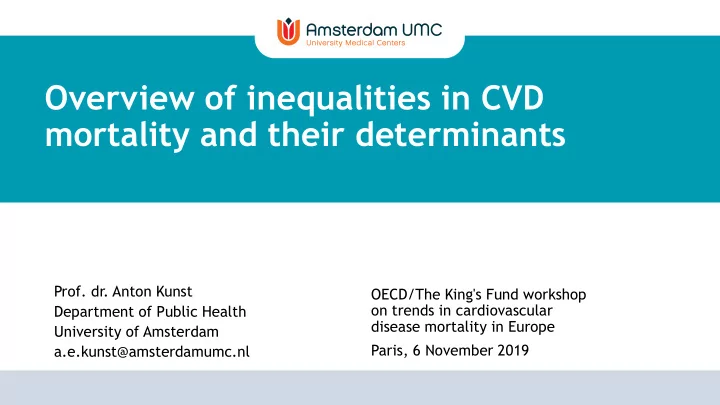

Overview of inequalities in CVD mortality and their determinants Prof. dr. Anton Kunst OECD/The King's Fund workshop on trends in cardiovascular Department of Public Health disease mortality in Europe University of Amsterdam Paris, 6 November 2019 a.e.kunst@amsterdamumc.nl
Secular decline in cardiovascular disease (CVD) mortality? Amiri, Janssen & Kunst . The decline in ischaemic heart disease mortality in seven European countries. J Epid Community Health 2011; 65: 676-81
Determinants of CVD mortality trends Reduced case-fatality • - improved technology and treatment - improved health services provision • Environment Reduced incidence - physical exposures • - biological factors (BMI, hypertension, etc.) - socio-cultural influences - life style (smoking, diet, stress, etc.) - social networks - societal position
Socioeconomic position Dimensions Educational level • Unemployment history • Occupation, position at work • Income (gained, household) • • Wealth (capital, assets) Housing conditions • • Prestige, power Inherent to social stratification
Socioeconomic inequalities in CVD mortality A stepwise “gradient” • • Larger than neoplasm mortality Up to twofold differences • • Both men and women • Evident also at area-level
women men Cause-specific mortality according to number of years of education • text Norway, 1990-97, men, 45-59 years Source: Norwegian “ Report No. 20 to the Storting (2006-2007 )”
women men Cause-specific mortality according to number of years of education • text Norway, 1990-97, men, 45-59 years Source: Norwegian “ Report No. 20 to the Storting (2006-2007 )”
women men Cause-specific mortality according to number of years of education • text Norway, 1990-97, women , 45-59 years Source: Norwegian “ Report No. 20 to the Storting (2006-2007 )”
Age-standardized mortality rates by deprivation • text score, England 2014-2016, age < 75 years. www.gov.uk/government/publications/health-profile-for-england- 2018/chapter-5-inequalities-in-health-2018/chapter-5-inequalities-in-health
Emergence and persistence of inequalities Ischemic heart disease changed • • Cerebrovascular disease has from “manager’s disease” to ever been a “disease of poverty” “disease of poverty” - in the USA until the 1960’s • Total CVD mortality: inequalities - reversal of gradient in 1960’s are still relatively small in South, - similar reversal later in Europe and large in eastern countries - last in southern Europe (1990’s)
Cardiovascular disease Title mortality rates among high and low educated men 35-79 years, 2010-2014 text • Source: Girolamo et al. Heart, 22 August 2019
Men Women
Recent trends Both high and low socioeconomic • • Absolute differences in CVD groups benefitted from recent mortality reduced, declines in CVD mortality relative inequalities remained • Clear widening only in Estonia (1990s) and Lithuania (2000s)
Low High education Trends in CVD mortality in 12 European populations Men 35-79 years
Low education High education Trends in CVD mortality in 12 European populations Women 35-79 years
Understanding socioeconomic inequalities in CVD mortality Health care utilisation Socio- CVD economic mortality position rate Life style (eg. smoking, diet & sport)
men women The importance of lifestyle Smoking • text Prevalence of adverse behaviors according to number of years of education Not eating Norway, 2000-2003, vegetables men and women 40-45 years Source: Norwegian “ Report No. 20 to the Storting (2006-2007 )”
women men men women The importance of lifestyle • text Prevalence of adverse Physical inactivity behaviors according to number of years of education Not eating Norway, 2000-2003, vegetables men and women 40-45 years Source: Norwegian “ Report No. 20 to the Storting (2006-2007 )”
Evidence from explanatory studies Important role of behavior-related • • Inequalities in health care use factors contributed less to CVD inequalities Smoking: especially north-western • and eastern European countries Alcohol use: eastern countries •
Understanding socioeconomic inequalities in CVD mortality ? Socio- Life style CVD economic (eg. smoking, mortality position diet & sport) rate
The importance of wider social context • text Dahlgren & Whitehead rainbow model
Why socioeconomic inequalities in smoking? Smoking initiation ratios by education, Netherlands • Smoking (norms) in families • Peer pressure to (stop) smoking • Social stigmatization of smokers • Smoking as coping mechanism Source : Nagelhout et al. BMC Public Health 2012, 12:303
Why socioeconomic inequalities in smoking? Smoking cessation ratios by education, Netherlands • Continuous stress, worries and lack of control • Smoking and pro-smoking norms in social networks • Poor access to effective cessation support Source : Nagelhout et al. BMC Public Health 2012, 12:303
Why socioeconomic inequalities in smoking? the role of preventive policies Pro-rich effects • • Equitable effects - early publicity campaigns - later publicity campaigns - early smoke-free policies - later smoke-free policies (voluntary, white-collar settings) (compulsory, comprehensive) - smoking cessation services - low-class oriented services
Relation to national socioeconomic context Inherent to social stratification • systems everywhere • No consistent association with income inequalities or generosity of welfare state Eastern European countries: • specific conditions
Specific socioeconomic policies Employment policies, • e.g. precarious labor contracts Housing and urban policies, • Borrell C, Malmusi D, Muntaner C. e.g. urban renewal programs Int J Health Serv. 2017 Jan;47(1):10-17 Protection of young children, • e.g. social assistance benefits
Implications for strategies to ensure continued decline in CVD mortality Consider potential impact from • Look beyond health care individual- • perspective of people in socially level prevention, and link up with disadvantaged positions other policy sectors
Thank you for your attention
Recommend
More recommend